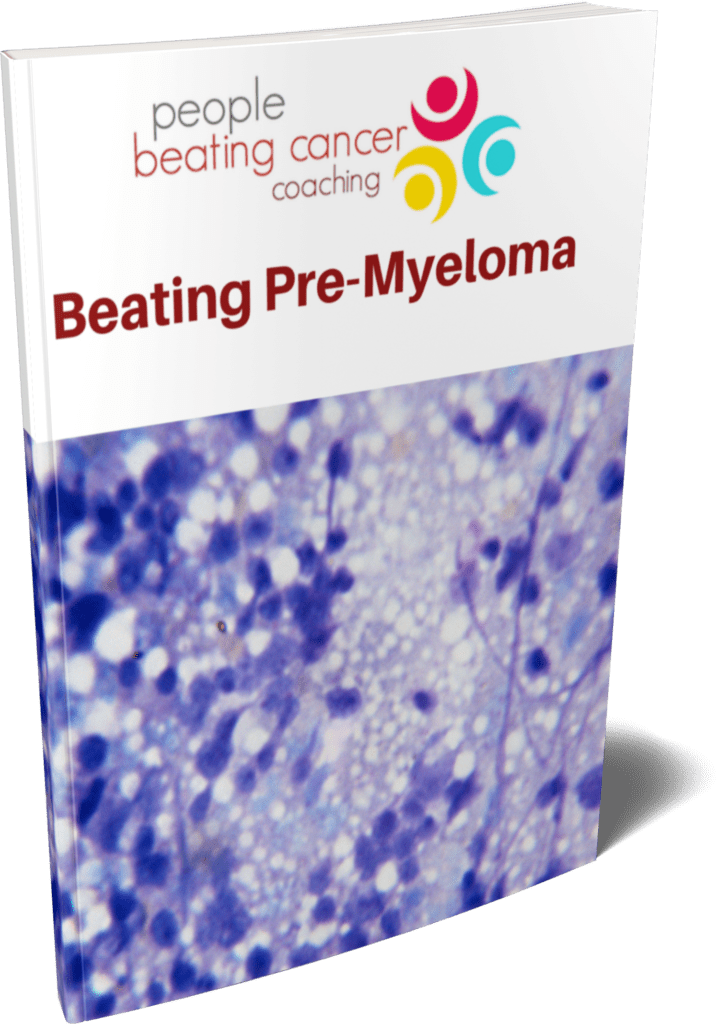
Diagnosed with SMM, SPB, or MGUS?
Learn how you can stall the development of full-blown Multiple Myeloma with evidence-based nutritional and supplementation therapies.
Click the orange button to the right to learn more.
- You are here:
- Home »
- Blog »
- Pre-Myeloma »
- Smoldering Multiple Myeloma?
Smoldering Multiple Myeloma?

Smoldering multiple myeloma with an increasingly abnormal serum free light chain (FLC) ratio is associated with a higher risk for progression to active multiple myeloma
Hi David- I was diagnosed with with monoclonal gammopathy of undetermined significance (MGUS) in 2009. I progressed to smoldering multiple myeloma (SMM) this year based on-
- My bone marrow biopsy, 10-20% plasma cells.
- My Freelight chain- kappa/lambda ratio increased,
- but no CRAB symptoms.
I am seeing hematologist/oncologist at university of new mexico comprehensive cancer center. She is watching and waiting for any changes. My questions are:
- Should I get a second opinion and if so from which facility?
- Does smoldering multiple myeloma always progress?
- Anti-angiogenic nutrition
- Anti-angiogenic, anti-inflammatory supplementation
- Anti-MM lifestyle therapies such as whole body hyperthermia
- MM Survivor
- MM Cancer Coach
- Director PeopleBeatingCancer
Recommended Reading:
Smoldering multiple myeloma
“Smouldering myeloma is a disease classified as intermediate in a spectrum of step-wise progressive diseases termed plasma cell dyscrasias. In this spectrum of diseases, a clone of plasma cells secreting monoclonal paraprotein (also termed myeloma protein or M protein) causes the relatively benign disease of monoclonal gammopathy of undetermined significance.
This clone proliferates and may slowly evolve into more aggressive sub-clones that cause smouldering multiple myeloma.
Further and more rapid evolution causes the overtly malignant stage of multiple myeloma and can subsequently lead to the extremely malignant stage of secondary plasma cell leukemia.[1][2][3] Thus, some patients with smouldering myeloma progress to multiple myeloma and plasma cell leukemia.
Smouldering myeloma, however, is not a malignant disease. It is characterised as a pre-malignant disease that lacks symptoms but is associated with bone marrow biopsy showing the presence of an abnormal number of clonal myeloma cells, blood and/or urine containing a myeloma protein, and a significant risk of developing into a malignant disease.[2]…
Diagnosis[edit]
Smoldering multiple myeloma is characterised by:[4]
- Serum paraprotein >30 g/l or urinary monoclonal protein ≥500 mg per 24 h AND/OR
- Clonal plasma cells >10% and <60% on bone marrow biopsy AND
- No evidence of end organ damage that can be attributed to plasma cell disorder AND
- No myeloma-defining event (>60% plasma cells in bone marrow OR Involved/Uninvolved light chain ratio>100)
Treatment[edit]
Treatment for multiple myeloma is focused on therapies that decrease the clonal plasma cell population and consequently decrease the signs and symptoms of disease. If the disease is completely asymptomatic (i.e. there is a paraprotein and an abnormal bone marrow population but no end-organ damage), as in smouldering myeloma, treatment is typically deferred, or restricted to clinical trials.[5]
They are generally responsive to IL-1β neutralisation.[6]
Prognosis[edit]
Smouldering myeloma with an increasingly abnormal serum free light chain (FLC) ratio is associated with a higher risk for progression to active multiple myeloma.[7]
Multiple Myeloma: Statistics
“The overall 5-year survival rate for people with multiple myeloma in the United States is 55%.
For the 4% of people who are diagnosed at an early stage, the 5-year survival rate is over 77%. If the cancer has spread to a distant part of the body, the 5-year survival rate is over 54%. Approximately 96% of cases are diagnosed at this stage…”


